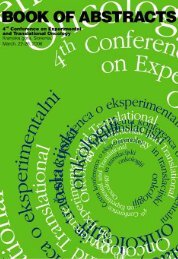Create successful ePaper yourself
Turn your PDF publications into a flip-book with our unique Google optimized e-Paper software.
Gene transfer into solid tumors by electroporation<br />
Suzana Mesojednik1, Darja Pavlin2, Gregor Serša1, Andrej Cör3, Simona Kranjc1, Alenka<br />
Grošel1, Gregor Tevž1, Urška Kamenšek1, Maja Čemažar1<br />
1Institute <strong>of</strong> Oncology Ljubljana, Dept. <strong>of</strong> Experimental Oncology, Zaloska 2, SI-1000 Ljubljana,<br />
Slovenia; 2University <strong>of</strong> Ljubljana, Veterinary Faculty, Cesta v Mestni log 47, SI-1000 Ljubljana, Slovenia;<br />
3University <strong>of</strong> Ljubljana, Faculty <strong>of</strong> Medicine, Korytkova 2, SI-1000 Ljubljana, Slovenia<br />
Electrogene transfer <strong>of</strong> plasmid DNA into tumors is a promising approach for the<br />
treatment <strong>of</strong> cancer. Feasibility and effectiveness <strong>of</strong> this method was already demonstrated,<br />
elaborating on pulse parameters and plasmid DNA construction. However, efficient in<br />
vivo use <strong>of</strong> electroporation for gene transfer into solid tumor types is still limited by low<br />
transfection efficiencies. In order to increase electrogene transfections <strong>of</strong> solid tumors<br />
some novel strategies considering tumor structural properties have to be found.<br />
To explore the influence <strong>of</strong> histological properties <strong>of</strong> different tumor types (B16F1<br />
melanoma, EAT carcinoma, SA-1 fibrosarcoma, LPB fibrosarcoma) on electrogene<br />
transfer, the correlation between cell density, collagen or proteoglycans content and<br />
transfection efficiencies was determined. Further, in order to increase transfection efficiency<br />
<strong>of</strong> electrogene transfer into tumors, the extracellular matrix <strong>of</strong> tumors was modulated by<br />
enzymes hyaluronidase or/and collagenase before electrotransfection.<br />
Our results demonstrate that s<strong>of</strong>t tumors with spherical and larger cell size, low<br />
proteoglycans and collagen content and low cell density are more effectively transfected<br />
(B16F1, EAT) than more rigid tumors with high proteoglycans and collagen content,<br />
small and spindle-shaped cells and high cell density (LPB and SA-1). Modulation <strong>of</strong><br />
extracellular components with enzymes collagenase and hyaluronidase can increase<br />
electrogene delivery into rigid tumor types such as fibrosarcomas. The highest transfection<br />
efficiencies were obtained when combination <strong>of</strong> enzymes were used.<br />
In conclusion, our study demonstrates that knowledge about histological properties <strong>of</strong><br />
p28<br />
tumors is important for development <strong>of</strong> <strong>of</strong> novel strategies to deliver sufficient amounts <strong>of</strong><br />
plasmid DNA to the tumor cells by electroporation. Namely, electrogene transfer might be<br />
improved by modulation <strong>of</strong> tumor extracellular matrix with enzymes such as collagenase<br />
and hyaluronidase.<br />
110
















